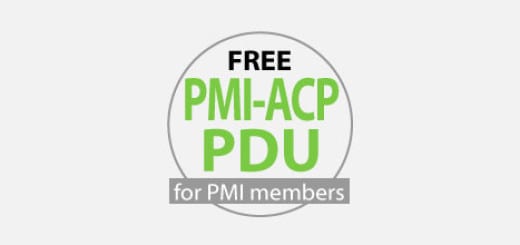PMI-ACP Study Notes: Domain II Value-Driven Delivery

[NEW! For the 2015 July PMI-ACP® Exam syllabus] The PMI-ACP® Exam consists of 120 questions which can be categorised into seven domain. The second domain: Domain II Value-Driven Delivery is the knowledge about “delivering valuable results by producing high-value increments for review, early and often, based on stakeholder priorities and collecting feedback from the stakeholders on these increments, and using this feedback to prioritize and improve future increments” (source: PMI-ACP® Examination Content Outline).
Domain II Value-Driven Delivery accounts for 20% of all questions in the PMI-ACP® Exam (i.e. ~24 questions among 120 PMI-ACP® Exam questions)
According to the PMI-ACP® Exam Content Outline, Domain II Value-Driven Delivery consists of 14 tasks grouped within 4 sub-domains:
Article Highlights
Define Positive Value
- Deliver work incrementally to gain competitive advantage and early realization of value.
- Maximize value delivered to stakeholders while at the same time minimize non-value added work.
- Reach consensus on the acceptance criteria of the deliverables.
- Refine project processes based on factors like team experience and organization preferences.
Avoid Potential Downsides (Control Risk)
- Make use of the concept of minimally marketable features (MMF) / minimally viable products (MVP) to deliver releasable increments fast.
- Solicit feedback from stakeholders and review frequently to enhance value.
- Fail fast by carrying out experiments / spikes early on to reduce risk.
Prioritization
- Collaborate with stakeholders to prioritize features in order to realize value early on.
- Review the backlog priorization with stakeholder frequently to optimize value delivery.
- Identify and prioritize continuously the various changing factors affecting the project in order to enhance quality and increase value.
- Both value producing and risk reducing work are prioritized in into the backlog in order to balance value and risks (non-value).
- Non-functional requirements (e.g. security, operations) will need to be considered and prioritized in order to minimize the likelihood of failure.
Incremental Development
- Develop the product incrementally to reduce risk and deliver value fast.
- Inspections, testings and reviews with stakeholders are carried out periodically to obtain feedback and make corrections as necessary.
- Retrospectives allow overall improvements to be made to the project process.
PMI-ACP® Study Notes: Domain II Value-Driven Delivery
Below is a collection of the key knowledge addressed in Domain II Value-Driven Delivery and the 14 tasks related to the domain:
- Value-driven delivery is an overarching principle for Agile projects. Projects are carried out to realize values (e.g. economic benefits, competitive advantages, reducing risks, regulatory compliance, etc.)
- In terms of Agile project management (and the PMI-ACP® exam), prioritization is the process where customers organize / select product backlog / user stories for implementation based on the perceived values
- Value-based Prioritization is to organize things so that the most important ones that deliver values are to be dealt with first
- Return on investment (ROI) / Net present value (NPV) / Internal rate of return (IRR)
- are metrics to assess prioritization based on monetary values
- return on investment (ROI) – the values a project realized (using present value) compared to the investment; a positive ROI means the project is profitable
- net present value (NPV) – the net future cash flow (profit – expenditure) in terms of today’s value (adjusted for future inflation, etc.); a positive NPV means the project is profitable
- internal rate of return (IRR) – this is somewhat like the interest rate of the investment; the higher the positive IRR, the more profitable the project
- are metrics to assess prioritization based on monetary values
- Customer-valued Prioritization
- deliver the highest value to the customers as early as possible
- the backlog should be customer-valued prioritized while taking into accounts technical feasibilities, risks, dependencies, etc. in order to win customer support
- Value Prioritization Schemes
- simple schemes – rank from high to low (priority 1, 2, 3, …)
- MoSCoW prioritization scheme – Must have, Should have, Could have, Would like to have, in future
- Monopoly money – ask customers to give out (fake) money to individual business features in order to compare the relative priority
- 100-Point method – customers are allowed to give, in total 100 points, to various features
- Dot voting / Multi-voting – everyone is given a limited number of dots (~20% of the number of all options) to vote on the options
- Kano analysis – plot the features on a graph with axes as Need Fulfilled / Not fulfilled vs Satisfied / Dissatisfied, each feature will then be classified as “exciters, satisfiers, dissatisfiers, indifferent”. Excitersare of highest values.
- Requirements Prioritization model – rate each feature by benefits for having, penalty for not having, cost of producing, risks, etc. and calculate a score using a pre-defined weighted formula
- CARVER (Criticality, Accessibility, Return, Vulnerability, Effect, and Recognizability) relative to the objective and mission of the project
- Criticality – how important to be done upfront
- Accessibility – can work on it immediately? or depends on other work / skills?
- Return – ROI / NPV / IRR
- Vulnerability – how easy to achieve the desired results?
- Effect – what are the effects on the project (help moving towards the goal of the project)?
- Recognizability – have the goals been clearly identified?
- Relative Prioritization / Ranking
- an ordered list of all user stories / features to be completed with 1 being the highest priority
- when new features are to be added, it has to be compare, in terms of priority, to all current features
- the schemes list above can be used to assist the relative prioritization / ranking tasks
- Minimally Marketable Features (MMF)
- the minimal functionality set (a group of user stories or a package of features) that can deliver values (e.g. useful) to the customers / end-users
- a distinct and deliverable feature of the system that provides significant values to the customer (can be sold / used immediately)
- chosen for implementation after value based prioritization
- can reap return on investment instantly
- the minimal functionality set (a group of user stories or a package of features) that can deliver values (e.g. useful) to the customers / end-users
- Minimal Viable Product (MVP)
- The minimal product (with just essential features and no more) that allows can be shipped to early adopters see and learn from the feedback instantly. The concept is somewhat similar to Minimally Marketable Feature (MMF) in which MVP is the first shippable product with the first set of MMF.
- Compliance
- conforming to a rule, such as a specification, policy, standard or law (e.g. regulatory compliance)
- compliance usually requires documentation, which is somewhat against the principles of agile (working software over documentation)
- a balance has to be struck (maybe with the help of Agile compliance management systems)
- Requirements Review
- a group of users and/or recognized experts carrying out reviews on the documented requirements
- to ensure that:
- requirements accurately reflect the needs and priorities of stakeholders
- requirements are technical feasible to be fulfilled
- Earned Value Management (EVM) for Agile Projects
- Earned Value Management is a tool used in traditional project management to measure the progress (in terms of realization of values) of the project
- In Agile, EVM is the measure of cost performance of the Agile project
- though the estimate and actual costs (money spent) can be plotted as a S-curve graph to clearly show whether the project is under- or over-budget, it does not tell whether the progress of the project is ahead of or behind schedule
- Value (story points and money) is calculated at the end of each iteration for work done
- For the construction of the graph for EVM:
- The baseline for comparison:
- number of planned iterations in a release
- planned story points in the release
- planned budget for the release
- Actual measurements:
- total story points completed
- number of iterations completed
- Actual Cost (actual spending) to date
- any story points added / removed from the plan (as Agile project requirements are ever-changing)
- Plotting the chart:
- x-axis: iterations / date
- y-axis: i) story points planned; ii) story points completed, iii) planned budget; iv) actual costs
- discrepancies between i) and ii) / iii) and iv) reflect the performance of the release
- The baseline for comparison:
- Formulas for EVM (not to be tested on the PMI-ACP® exam)
- Schedule Performance Index (SPI) = Earned Value / Planned Value
- Cost Performance Index (CPI) = Earned Value / Actual Cost
- EVM does not indicate the quality of the project outcome, i.e. whether the project is successful or not
- Approved Iterations
- After the time assigned to an iteration has been used up, the team will hold a review meeting with the stakeholders (mainly management and customers) to demonstrate the working increments from the iteration.
- If stakeholders approve the product increment against the backlog selected for the iteration, the iteration is said to be approved.
- Approved iterations may be used in the contract of work as a way to structure the release of partial payment to the contractor.
Summary: Domain II Value-Driven Delivery
This PMI-ACP® Exam Study notes covers the second domain: Domain II Value-Driven Delivery of the new 2015 PMI-ACP® Exam syllabus. Domain II accounts for 20% (~24 questions) of all questions to be found on the PMI-ACP® Exam.
Most Popular PMI-ACP Certification Articles
- Top 10 Tips to Prepare for the exam (I got all Proficient in my exam)
- How to Get 21 Contact Hours?
- Over 600+ FREE Quality Mock Exam / Practice Questions





 Hi, my name is Edward Chung, PMP, PMI-ACP®, ITIL® Foundation. Like most of us, I am a working professional pursuing career advancements through Certifications. As I am having a full-time job and a family with 3 kids, I need to pursue professional certifications in the most effective way (i.e. with the least amount of time). I share my exam tips here in the hope of helping fellow Certification aspirants!
Hi, my name is Edward Chung, PMP, PMI-ACP®, ITIL® Foundation. Like most of us, I am a working professional pursuing career advancements through Certifications. As I am having a full-time job and a family with 3 kids, I need to pursue professional certifications in the most effective way (i.e. with the least amount of time). I share my exam tips here in the hope of helping fellow Certification aspirants!





